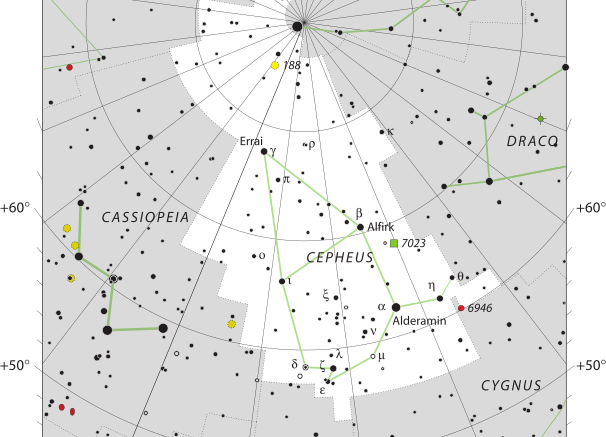Cepheus is a constellation in the northern sky, named after Cepheus, a king of Aethiopia in Greek mythology.
Cepheus has one star with known planets and contains no Messier objects. The brightest star in the constellation is Alderamin, Alpha Cephei. There are no meteor showers associated with Cepheus.
Cepheus is most commonly depicted as holding his arms aloft, praying for the deities to spare the life of Andromeda. He also is depicted as a more regal monarch sitting on his throne.
| Applicable Information | |
| Visibility In Pacific Northwest | Circumpolar (always visible in the Pacific Northwest) |
| Best Times To View | November |
| Right Ascension | 20h 01m 56.4481s–09h 03m 19.7931s |
| Declination | 88.6638870°–53.3532715° |
| Area | 588 square degrees |
| Main Stars | 7 |
| Brightest Object | α Cep |
| Meteor showers | 0 |
| Messier objects | 0 |
| Neighboring Constellations | Cygnus, Lacerta, Cassiopeia, Camelopardalis, Draco, Ursa Minor |
History
In Chinese astronomy, the stars of the constellation Cepheus are found in two areas: the Purple Forbidden enclosure and the Black Tortoise of the North.
In Greek Mythology, Cepheus was the King of Aethiopia. He was married to Cassiopeia and was the father of Andromeda, both of whom are immortalized as modern day constellations along with Cepheus.
Stars
The constellation contains four formally named stars. The star names approved by the International Astronomical Union (IAU) are Alderamin, Alfirk, Errai, and Kurhah.
There are several prominent double stars and binary stars in the constellation. Omicron Cephei is a binary star, while Xi Cephei is a binary star, and Kruger 60 is a binary star.
There are 3 red supergiants in the constellation that are visible to the naked eye.
Deep Sky Objects
- NGC 188 is an open cluster that has the distinction of being the closest open cluster to the north celestial pole, as well as one of the oldest-known open clusters.
- NGC 6946 is a spiral galaxy in which ten supernovae have been observed, more than in any other galaxy.
- IC 469 is another spiral galaxy, characterized by a compact nucleus, of oval shape, with perceptible side arms.
- The nebula NGC 7538 is home to the largest-yet-discovered protostar.
- NGC 7023 is a reflection nebula with an associated star cluster (Collinder 429); it has an overall magnitude of 7.7 and is 1,400 light-years from Earth. The nebula and cluster are located near Beta Cephei and T Cephei.
- S 155, also known as the Cave Nebula, is a dim and very diffuse bright nebula within a larger nebula complex containing emission, reflection, and dark nebulosity.
- The quasar 6C B0014+8120 is one of the most powerful objects in the universe, powered by a supermassive black hole equivalent to 40 billion Suns.
Make sure to check out other articles on the site, including a brief introduction to constellations, other constellation articles, and more!

Be the first to comment on "Cepheus"